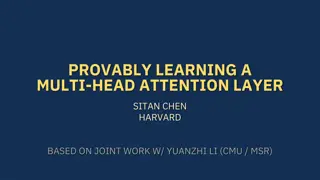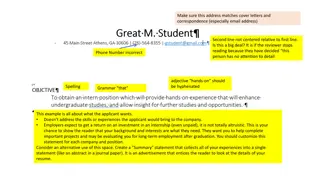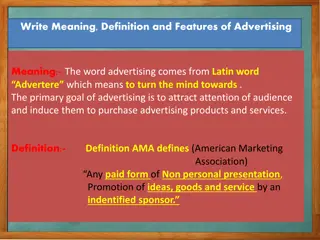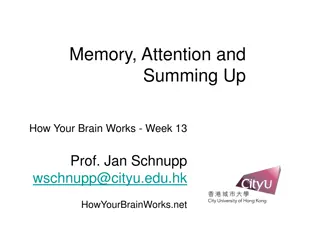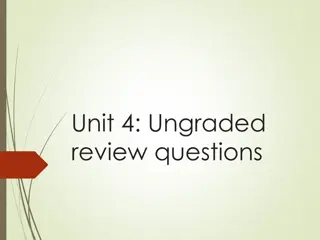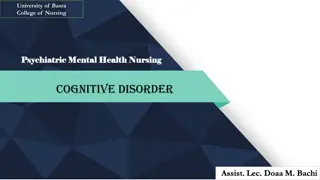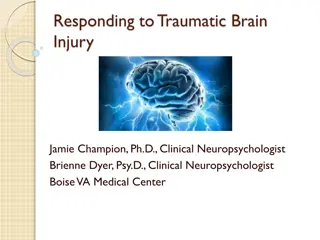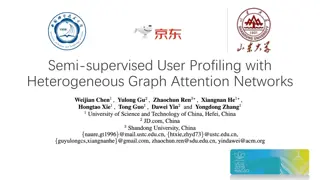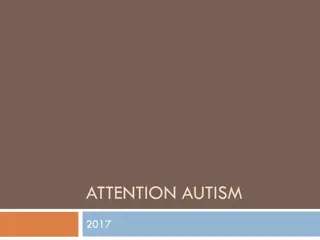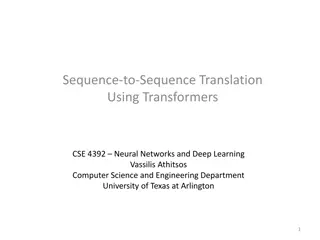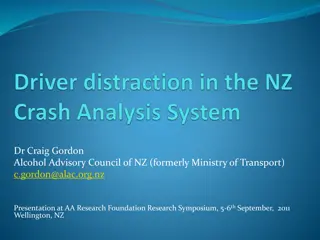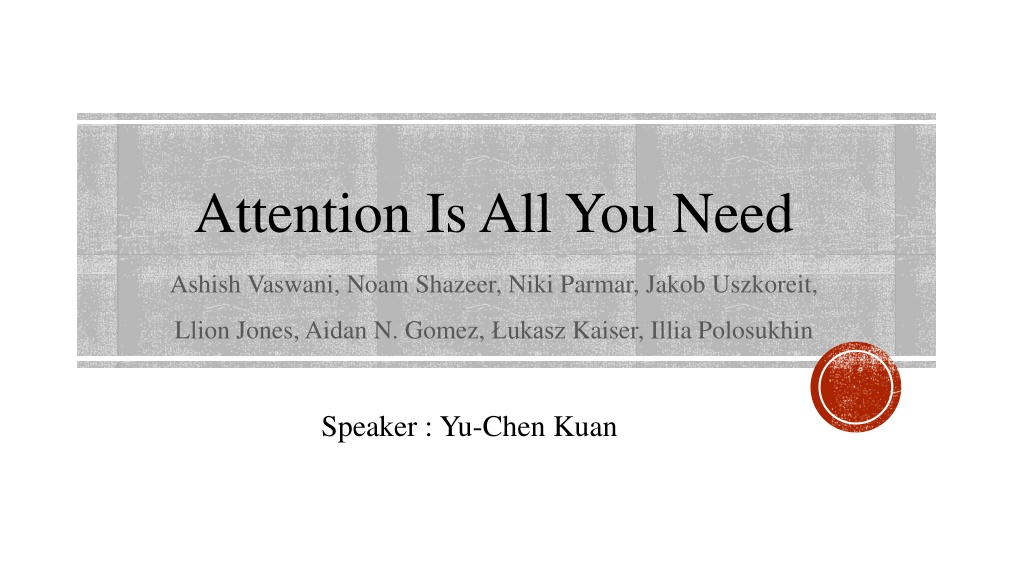
Transforming Sequence Modeling with Self-Attention Mechanisms
Dive into the revolutionary research paper "Attention Is All You Need" by Ashish Vaswani, Noam Shazeer, and team, introducing the Transformer model architecture that relies solely on attention mechanisms, breaking away from traditional recurrent models. Explore how self-attention allows for parallelization, reducing sequential computation and enhancing sequence modeling capabilities. Understand the significance of attention mechanisms in various tasks such as language modeling and machine translation, paving the way for more efficient and effective models.
Download Presentation

Please find below an Image/Link to download the presentation.
The content on the website is provided AS IS for your information and personal use only. It may not be sold, licensed, or shared on other websites without obtaining consent from the author. Download presentation by click this link. If you encounter any issues during the download, it is possible that the publisher has removed the file from their server.
E N D
Presentation Transcript
Attention Is All You Need Ashish Vaswani, Noam Shazeer, Niki Parmar, Jakob Uszkoreit, Llion Jones, Aidan N. Gomez, ukasz Kaiser, Illia Polosukhin Speaker : Yu-Chen Kuan
OUTLINE Conclusion Introduction Appendix Background Model Architecture Why Self-Attention Training Results 2
Introduction RNN, LSTM, GRU have been firmly established as state of the art approaches in sequence modeling and transduction problems. such as language modeling and machine translation recurrent language models and encoder-decoder architectures Recurrent models typically factor computation along the symbol positions of the input and output sequences. The inherently sequential nature precludes parallelization within training examples 4
Introduction Attention mechanisms have become an integral part of compelling sequence modeling and transduction models in various tasks. allowing modeling of dependencies without regard to their distance in the input or output sequences used in conjunction with a recurrent network In this work we propose the Transformer, a model architecture eschewing recurrence and instead relying entirely on an attention mechanism. 5
Background The goal of reducing sequential computation forms the foundation of the Extended Neural GPU , ByteNet and ConvS2S. use convolutional neural networks as basic building block the number of operations required to relate signals grows in the distance between positions difficult to learn dependencies between distant positions In the Transformer , reduced to a constant number of operations. 7
Background Self-attention, is an attention mechanism relating different positions of a single sequence in order to compute a representation of the sequence. sometimes called intra-attention The Transformer is the first transduction model relying entirely on self- attention to compute representations of its input and output. without using sequence-aligned RNNs or convolution 8
Model Architecture Most competitive neural sequence transduction models have an encoder-decoder structure. The Transformer follows this overall architecture using stacked self-attention and point-wise, fully connected layers for both the encoder and decoder. 10
Model Architecture encoder input sequence: X = (x1, ... , xn) encoder output sequence: Z = (z1, ..., zn) decoder output sequence: Y = (y1, ..., ym) Transformer 11
Model Architecture The encoder is composed of a stack of N = 6 identical layers. The first is a multi-head self-attention mechanism. The second is a fully connected feed-forward network. Encoder 12
Model Architecture The decoder is also composed of a stack of N = 6 identical layers. Third sub-layer, which performs multi-head attention over the output of the encoder stack. Decoder 13
Model Architecture The input consists of queries and keys of dimension dk, and values of dimension dv. The two most commonly used attention functions are additive attention , and dot-product attention. Scaled Dot-Product Attention 14
Model Architecture Multi-head attention allows the model to jointly attend to information from different representation 8 subspaces at different positions. Multi-Head Attention 15
Model Architecture Transformer uses multi-head attention in three different ways: In "encoder-decoder attention" layers, the queries come from the previous decoder layer, and 1. the memory keys and values come from the output of the encoder. The encoder contains self-attention layers. 2. Self-attention layers in the decoder allow each position in the decoder to attend to all 3. positions in the decoder up to and including that position. 16
Model Architecture 1. 3. 2. 17
Model Architecture Each of the layers in our encoder and decoder contains a fully connected feed-forward network. Consists of two linear transformations with a ReLU activation in between. 18
Model Architecture Learned linear transformation and softmax function to convert the decoder output to predicted next-token probabilities. Share the same weight matrix between the two embedding layers and the pre-softmax linear transformation. 19
Model Architecture In order for the model to make use of the order of the sequence, we add positional encodings. sine and cosine functions of different frequencies: Each dimension of the positional encoding corresponds to a sinusoid. 20
Model Architecture Allow the model to easily learn to attend by relative positions. Allow the model to extrapolate to sequence lengths longer than the ones encountered during training. 21
Why Self-Attention Three desiderata: 1. total computational complexity per layer. 2. the amount of computation that can be parallelized. 3. the path length between long-range dependencies in the network. 23
Why Self-Attention Sequential Operations Self-Attention V.S. RNN Complexity When n < d, Self-Attention faster than RNN. Such as word-piece and byte-pair. 24
Why Self-Attention Self-Attention(restricted) restricted to neighborhood of size r Convolutional Kernel width k < n, doesn t connect all pairs of input and output positions. 25
Why Self-Attention Convolutional To increase the length: Contiguous kernels: stack of O(n/k) Dilated convolutions: stack of O(logk(n)) Convolution V.S. Recurrence Separable convolutions: Decrease complexity to O(k n d+n d2) 26
Training Training Data and Batching: For English-German, train on the standard WMT 2014 English-German dataset consisting of about 4.5 million sentence pairs,sentences were encoded using byte-pair encoding. For English-French, used the significantly larger WMT 2014 English-French dataset consisting of 36M sentences and split tokens into a 32000 word-piece vocabulary. Each training batch contained a set of sentence pairs containing approximately 25000 source tokens and 25000 target tokens. 28
Training Hardware and Schedule : trained with 8 NVIDIA P100 GPUs For base models, each training step took about 0.4 seconds. Trained the base models for a total of 100,000 steps or 12 hours. For big models, step time was 1.0 seconds. The big models were trained for 300,000 steps (3.5 days). 29
Training Optimizer : Adam optimizer with 1= 0.9, 2= 0.98 and = 10 9. Learning rate formula ( warmup_steps = 4000 ): 30
Training Regularization Residual Dropout : 1. apply dropout to the output of each sub-layer, before Add & Norm. 2. apply dropout to the sums of the embeddings and the positional encodings . 3. Pdrop = 0.1 Label Smoothing: 1. label smoothing of value ls = 0.1 2. model learns to be more unsure, but improves accuracy and BLEU score. 31
Result 33
Result For the base models, used a single model obtained by averaging the last 5 checkpoints, written at 10-minute intervals. For the big models, averaged the last 20 checkpoints. Beam search with a beam size of 4 and length penalty = 0.6. 34
Result 35
Result 36
Result Performed only a small number of experiments to select the dropout, both attention and residual. Other parameters remained unchanged from the English-to-German base translation model. The maximum output length to input length + 300. Beam size of 21 and = 0.3 for both setting. 37
Conclusion The first sequence transduction model based entirely on attention. For translation tasks, the Transformer can be trained significantly faster than architectures based on recurrent or convolutional layers. Plan to extend the Transformer to problems involving input and output modalities other than text and to investigate local, restricted attention mechanisms to efficiently handle large inputs and outputs. 39
Appendix As side benefit, self-attention could yield more interpretable models. Not only do individual attention heads clearly learn to perform different tasks, many appear to exhibit behavior related to the syntactic and semantic structure of the sentences. 41
Appendix 42
Appendix 43
Appendix 44




